The feasibility of implementing text messaging system to support smoking cessation for smokers in Hanoi
The study was carried out to assess the feasibility of implementing text messaging system to
support smoking cessation smokers in Hanoi. This was a pilot study done on 40 smokers in Hanoi.
The participants received short message service texting within 6 weeks to get smoking cessation
support. The study was an intervention one which compared the participants’ smoking before and
after the intervention done. The participants were interviewed directly with a questionnaire that
includes the following contents: suitability of number/ content of messages, frequency/ time of
sending messages, use of received messages, interaction with the program, satisfaction with the
messaging system, and change in smoking behavior. The results showed that there were 82.5%
reading/using text messages daily, 82.5% interacted with program – by 2-way text messaging;
90% of the participants found the messages useful; 97.7% were satisfied with the program. The
researched subjects commented that the program was easy to use. 20% of the participants quit
smoking/ waterpipe tobacco completely; 15% quit smoking but still smoke waterpipe tobacco.
Smoking behavior changed positively compared to the initial survey; the statistical significance
included the number of cigarettes/waterpipe tobaccos smoked a day, the status of smoking
cigarettes/waterpipe tobacco (p <0.001). The rate of research subjects who tried to stop smoking
cigarettes/pipe tobacco in 4 weeks was quite high (52.5% before the intervention and 25% after the
intervention). This study provided evidence of the feasibility of the use of a text messaging
program to provide intervention supports in smoking cessation for Vietnamese people.
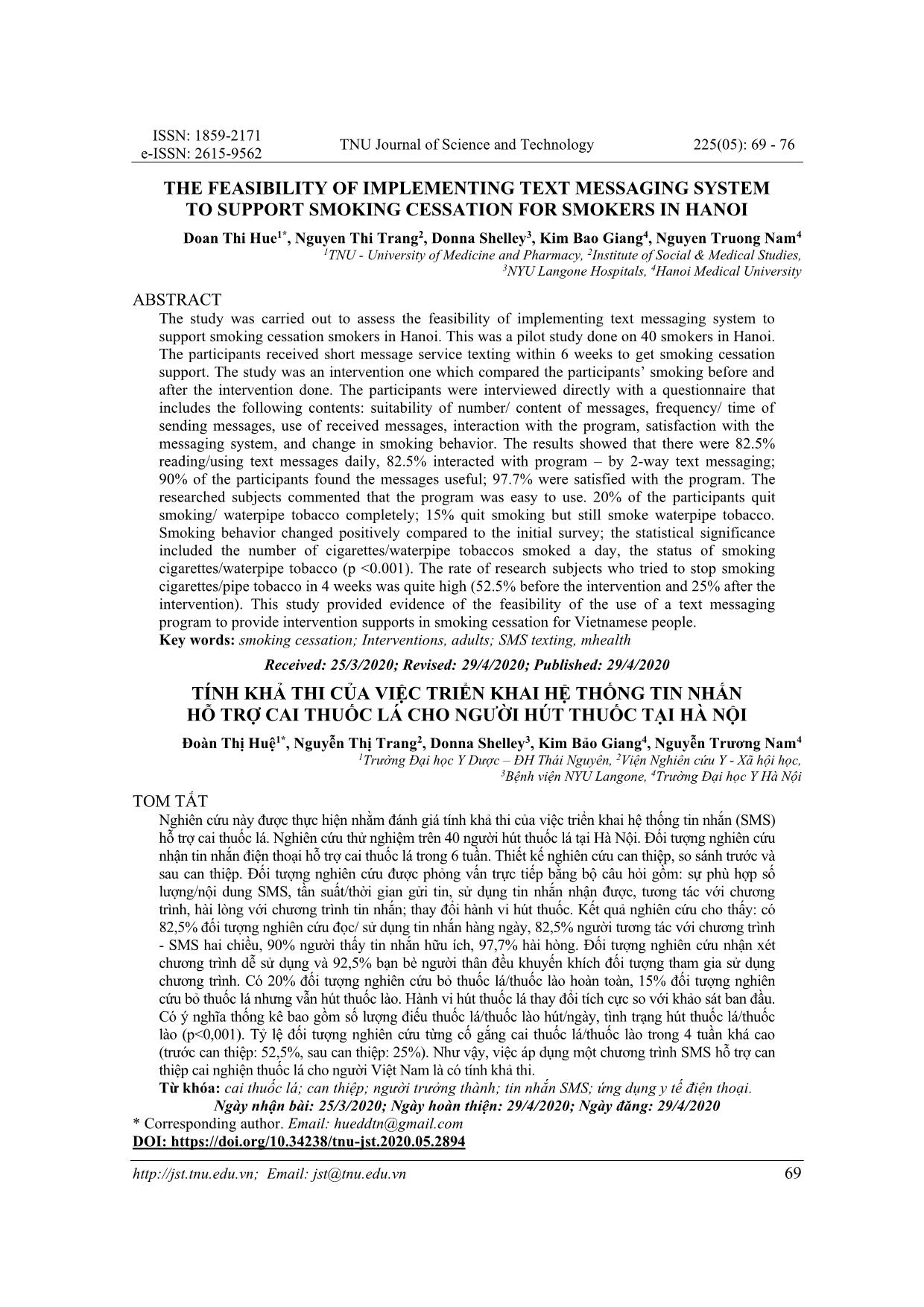
Trang 1
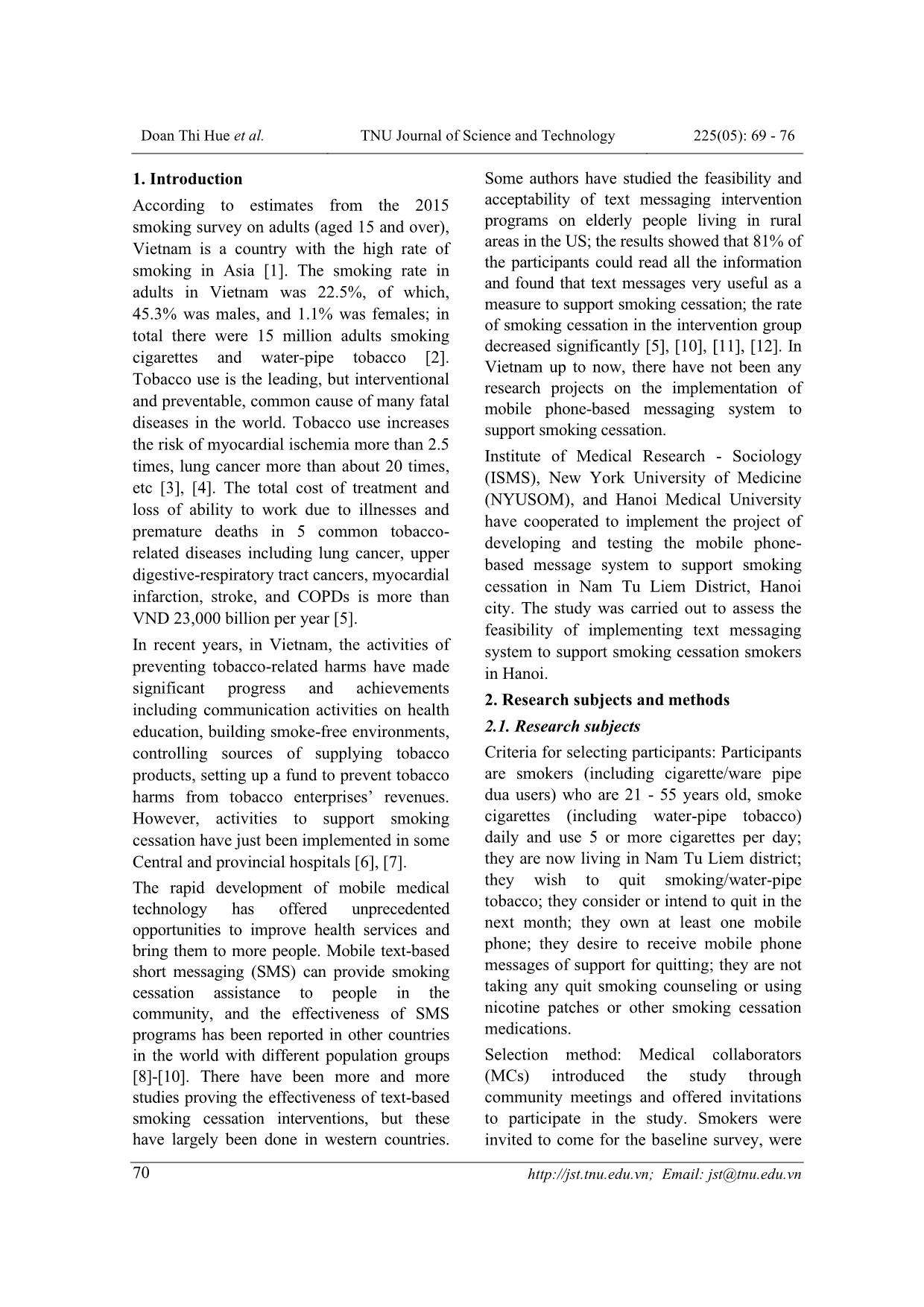
Trang 2
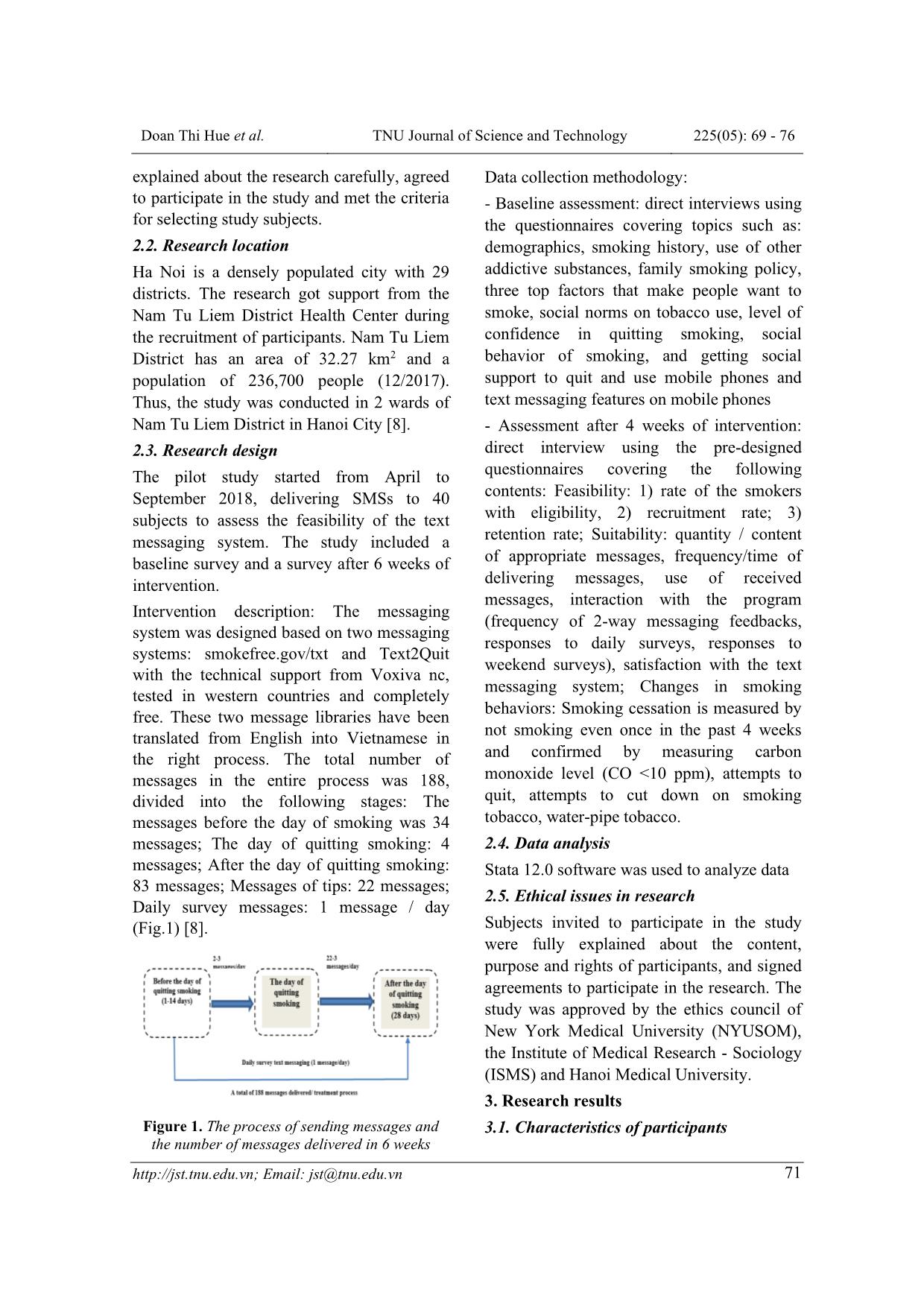
Trang 3
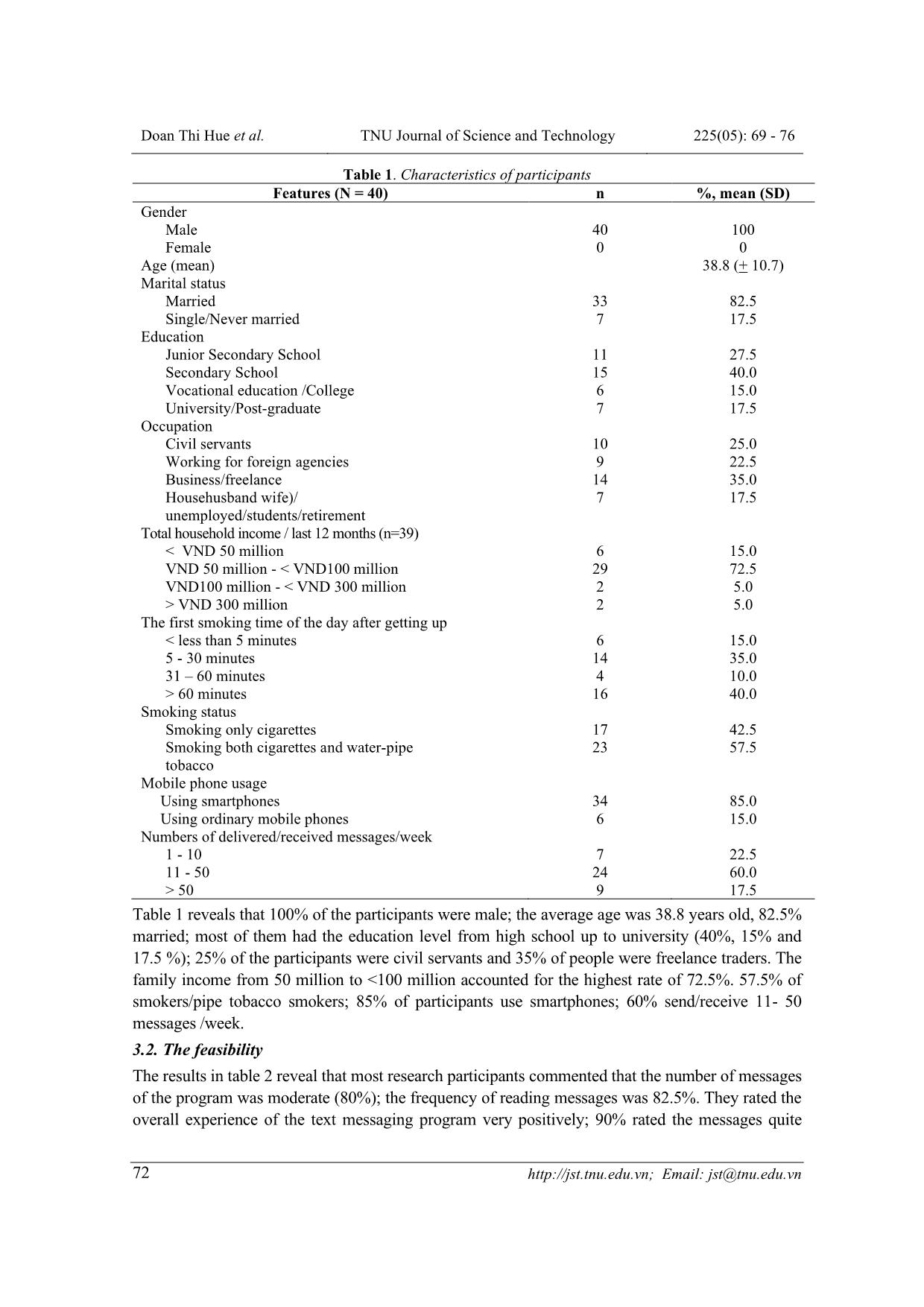
Trang 4
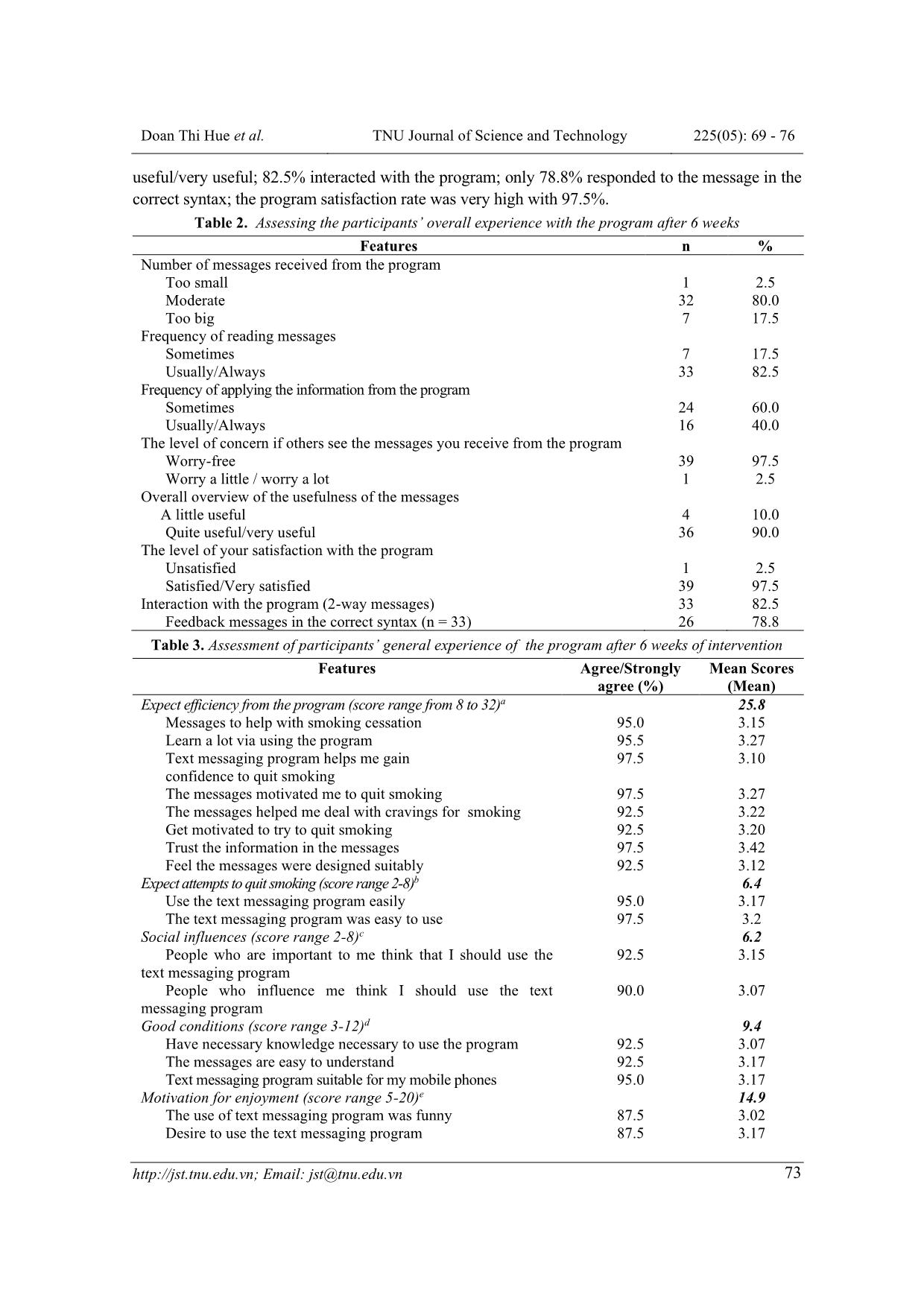
Trang 5
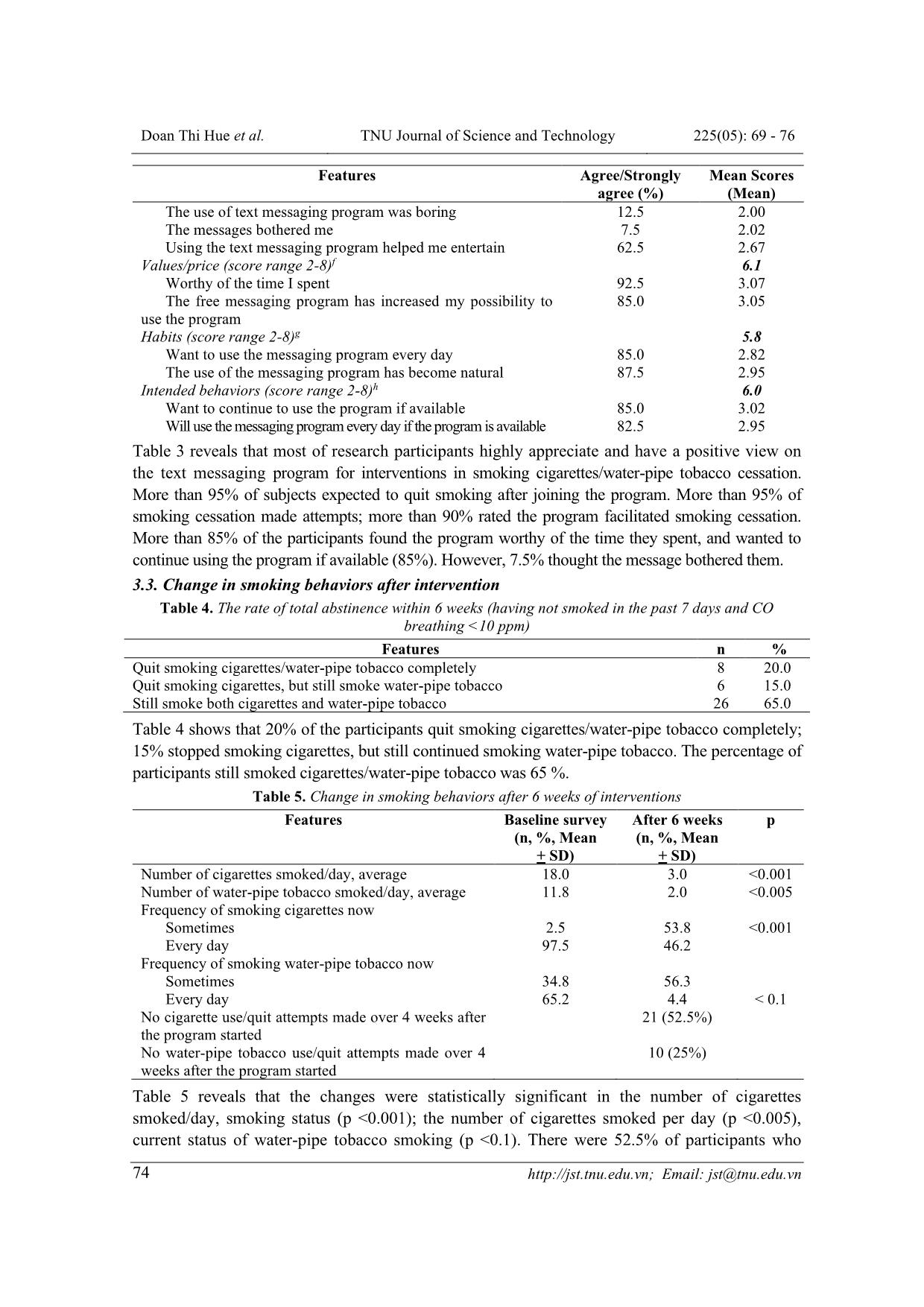
Trang 6
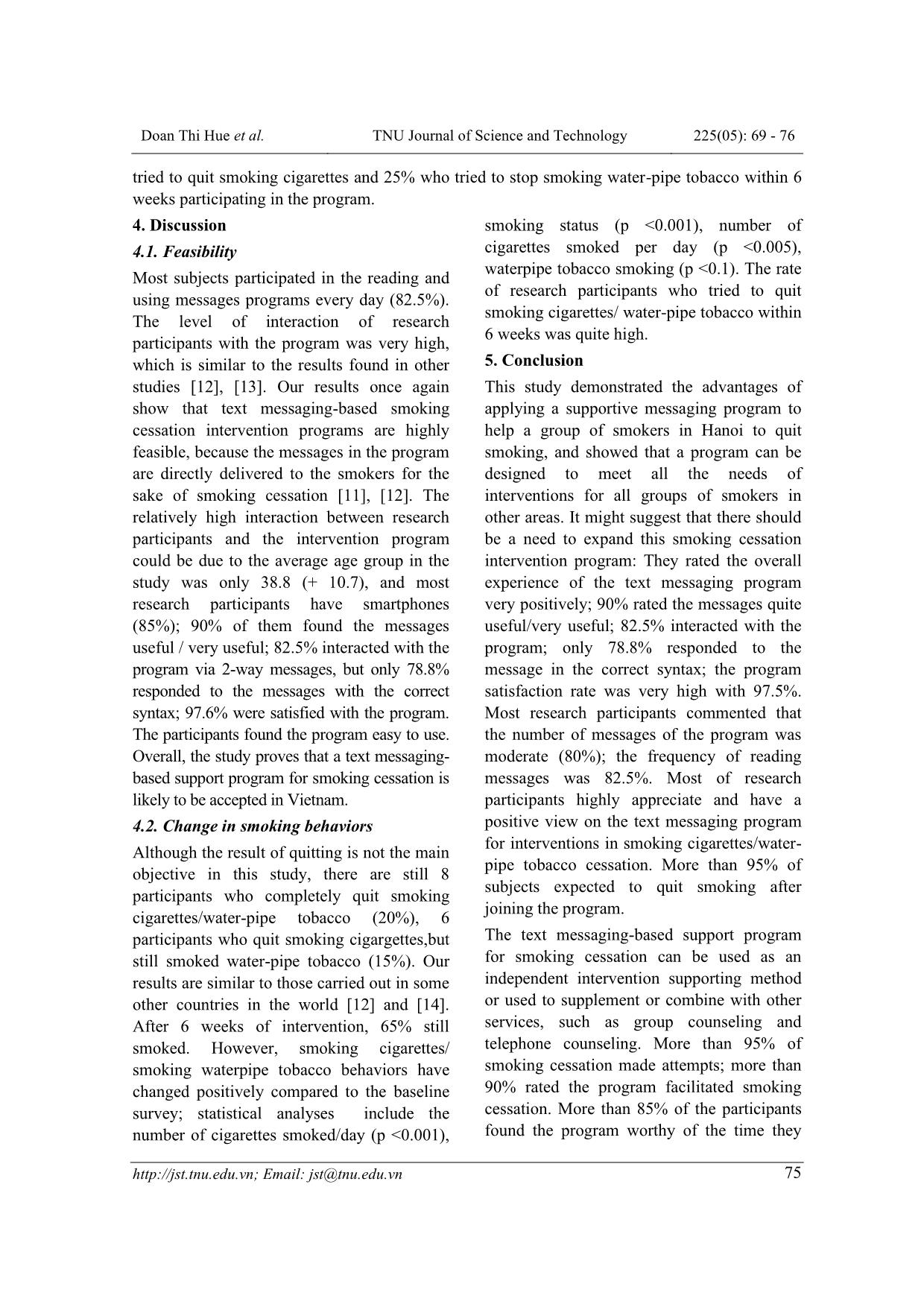
Trang 7
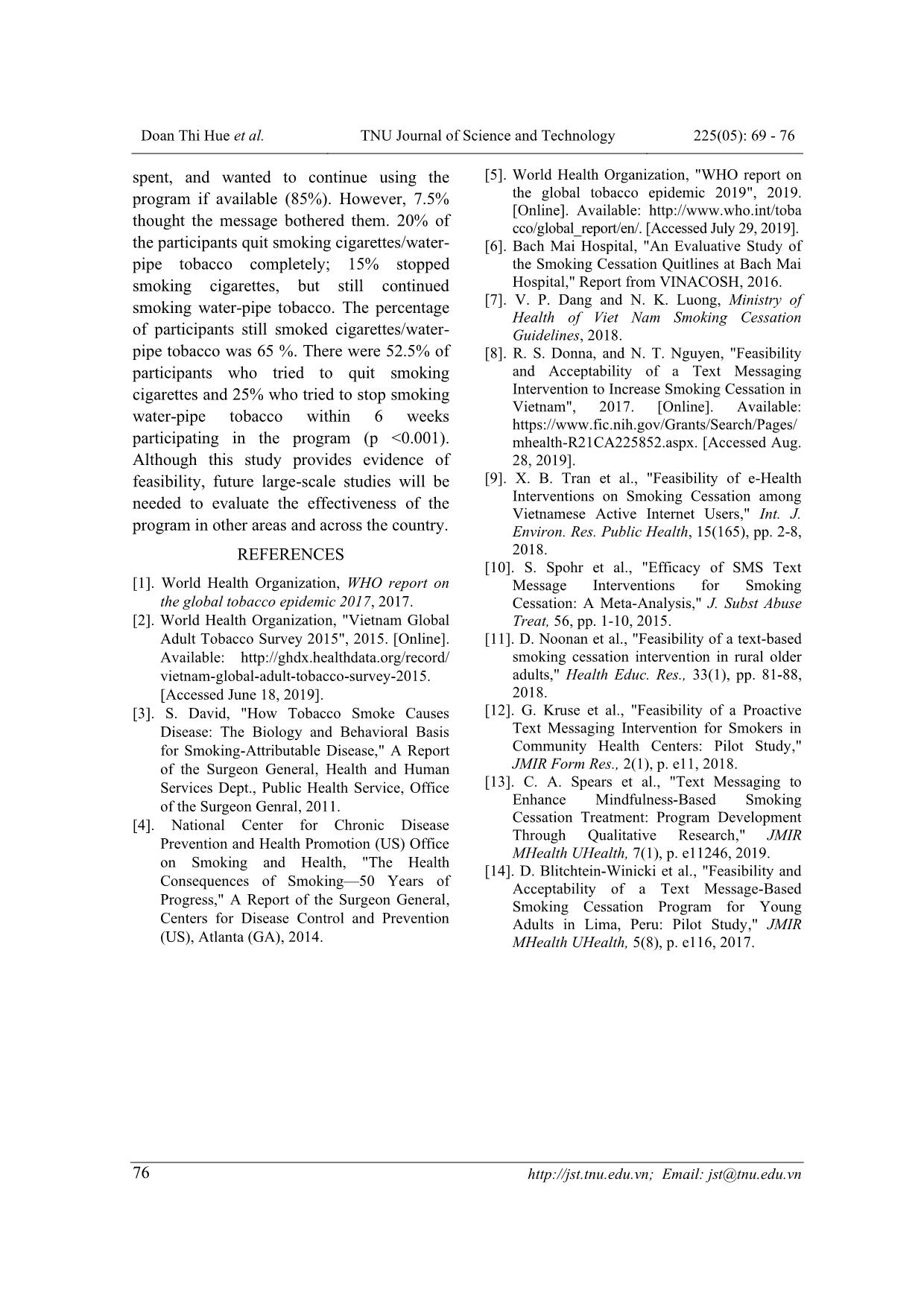
Trang 8
Tóm tắt nội dung tài liệu: The feasibility of implementing text messaging system to support smoking cessation for smokers in Hanoi
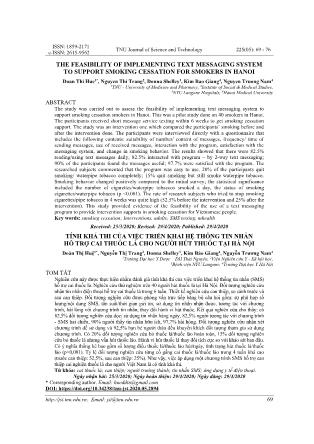
ISSN: 1859-2171 e-ISSN: 2615-9562 TNU Journal of Science and Technology 225(05): 69 - 76 Email: jst@tnu.edu.vn 69 THE FEASIBILITY OF IMPLEMENTING TEXT MESSAGING SYSTEM TO SUPPORT SMOKING CESSATION FOR SMOKERS IN HANOI Doan Thi Hue1*, Nguyen Thi Trang2, Donna Shelley3, Kim Bao Giang4, Nguyen Truong Nam4 1TNU - University of Medicine and Pharmacy, 2Institute of Social & Medical Studies, 3NYU Langone Hospitals, 4Hanoi Medical University ABSTRACT The study was carried out to assess the feasibility of implementing text messaging system to support smoking cessation smokers in Hanoi. This was a pilot study done on 40 smokers in Hanoi. The participants received short message service texting within 6 weeks to get smoking cessation support. The study was an intervention one which compared the participants’ smoking before and after the intervention done. The participants were interviewed directly with a questionnaire that includes the following contents: suitability of number/ content of messages, frequency/ time of sending messages, use of received messages, interaction with the program, satisfaction with the messaging system, and change in smoking behavior. The results showed that there were 82.5% reading/using text messages daily, 82.5% interacted with program – by 2-way text messaging; 90% of the participants found the messages useful; 97.7% were satisfied with the program. The researched subjects commented that the program was easy to use. 20% of the participants quit smoking/ waterpipe tobacco completely; 15% quit smoking but still smoke waterpipe tobacco. Smoking behavior changed positively compared to the initial survey; the statistical significance included the number of cigarettes/waterpipe tobaccos smoked a day, the status of smoking cigarettes/waterpipe tobacco (p <0.001). The rate of research subjects who tried to stop smoking cigarettes/pipe tobacco in 4 weeks was quite high (52.5% before the intervention and 25% after the intervention). This study provided evidence of the feasibility of the use of a text messaging program to provide intervention supports in smoking cessation for Vietnamese people. Key words: smoking cessation; Interventions, adults; SMS texting, mhealth Received: 25/3/2020; Revised: 29/4/2020; Published: 29/4/2020 TÍNH KHẢ THI CỦA VIỆC TRIỂN KHAI HỆ THỐNG TIN NHẮN HỖ TRỢ CAI THUỐC LÁ CHO NGƯỜI HÚT THUỐC TẠI HÀ NỘI Đoàn Thị Huệ1*, Nguyễn Thị Trang2, Donna Shelley3, Kim Bảo Giang4, Nguyễn Trương Nam4 1Trường Đại học Y Dược – ĐH Thái Nguyên, 2Viện Nghiên cứu Y - Xã hội học, 3Bệnh viện NYU Langone, 4Trường Đại học Y Hà Nội TOM TẮT Nghiên cứu này được thực hiện nhằm đánh giá tính khả thi của việc triển khai hệ thống tin nhắn (SMS) hỗ trợ cai thuốc lá. Nghiên cứu thử nghiệm trên 40 người hút thuốc lá tại Hà Nội. Đối tượng nghiên cứu nhận tin nhắn điện thoại hỗ trợ cai thuốc lá trong 6 tuần. Thiết kế nghiên cứu can thiệp, so sánh trước và sau can thiệp. Đối tượng nghiên cứu được phỏng vấn trực tiếp bằng bộ câu hỏi gồm: sự phù hợp số lượng/nội dung SMS, tần suất/thời gian gửi tin, sử dụng tin nhắn nhận được, tương tác với chương trình, hài lòng với chương trình tin nhắn; thay đổi hành vi hút thuốc. Kết quả nghiên cứu cho thấy: có 82,5% đối tượng nghiên cứu đọc/ sử dụng tin nhắn hàng ngày, 82,5% người tương tác với chương trình - SMS hai chiều, 90% người thấy tin nhắn hữu ích, 97,7% hài hòng. Đối tượng nghiên cứu nhận xét chương trình dễ sử dụng và 92,5% bạn bè người thân đều khuyến khích đối tượng tham gia sử dụng chương trình. Có 20% đối tượng nghiên cứu bỏ thuốc lá/thuốc lào hoàn toàn, 15% đối tượng nghiên cứu bỏ thuốc lá nhưng vẫn hút thuốc lào. Hành vi hút thuốc lá thay đổi tích cực so với khảo sát ban đầu. Có ý nghĩa thống kê bao gồm số lượng điếu thuốc lá/thuốc lào hút/ngày, tình trạng hút thuốc lá/thuốc lào (p<0,001). Tỷ lệ đối tượng nghiên cứu từng cố gắng cai thuốc lá/thuốc lào trong 4 tuần khá cao (trước can thiệp: 52,5%, sau can thiệp: 25%). Như vậy, việc áp dụng một chương trình SMS hỗ trợ can thiệp cai nghiện thuốc lá cho người Việt Nam là có tính khả thi. Từ khóa: cai thuốc lá; can thiệp; người trưởng thành; tin nhắn SMS; ứng dụng y tế điện thoại. Ngày nhận bài: 25/3/2020; Ngày hoàn thiện: 29/4/2020; Ngày đăng: 29/4/2020 * Corresponding author. Email: hueddtn@gmail.com DOI: https://doi.org/10.34238/tnu-jst.2020.05.2894 Doan Thi Hue et al. TNU Journal of Science and Technology 225(05): 69 - 76 Email: jst@tnu.edu.vn 70 1. Introduction According to estimates from the 2015 smoking survey on adults (aged 15 and over), Vietnam is a country with the high rate of smoking in Asia [1]. The smoking rate in adults in Vietnam was 22.5%, of which, 45.3% was males, and 1.1% was females; in total there were 15 million adults smoking cigarettes and water-pipe tobacco [2]. Tobacco use is the leading, but interventional and preventable, common cause of many fatal diseases in the world. Tobacco use increases the risk of myocardial ischemia more than 2.5 times, lung cancer more than about 20 times, etc [3], [4]. The total cost of treatment and loss of ability to work due to illnesses and premature deaths in 5 common tobacco- related diseases including lung cancer, upper digestive-respiratory tract cancers, myocardial infarction, stroke, and COPDs is more than VND 23,000 billion per year [5]. In recent years, in Vietnam, the activities of preventing tobacco-related harms have made significant progress and achievements including communication activities on health education, building smoke-free environments, controlling sources of supplying tobacco products, setting up a fund to prevent tobacco harms from tobacco enterprises’ revenues. However, activities to support smoking cessation have just been implemented in some Central and provincial hospitals [6], [7]. The rapid development of mobile medical t ... ble 1 reveals that 100% of the participants were male; the average age was 38.8 years old, 82.5% married; most of them had the education level from high school up to university (40%, 15% and 17.5 %); 25% of the participants were civil servants and 35% of people were freelance traders. The family income from 50 million to <100 million accounted for the highest rate of 72.5%. 57.5% of smokers/pipe tobacco smokers; 85% of participants use smartphones; 60% send/receive 11- 50 messages /week. 3.2. The feasibility The results in table 2 reveal that most research participants commented that the number of messages of the program was moderate (80%); the frequency of reading messages was 82.5%. They rated the overall experience of the text messaging program very positively; 90% rated the messages quite Doan Thi Hue et al. TNU Journal of Science and Technology 225(05): 69 - 76 Email: jst@tnu.edu.vn 73 useful/very useful; 82.5% interacted with the program; only 78.8% responded to the message in the correct syntax; the program satisfaction rate was very high with 97.5%. Table 2. Assessing the participants’ overall experience with the program after 6 weeks Features n % Number of messages received from the program Too small Moderate Too big 1 32 7 2.5 80.0 17.5 Frequency of reading messages Sometimes Usually/Always 7 33 17.5 82.5 Frequency of applying the information from the program Sometimes Usually/Always 24 16 60.0 40.0 The level of concern if others see the messages you receive from the program Worry-free Worry a little / worry a lot 39 1 97.5 2.5 Overall overview of the usefulness of the messages A little useful Quite useful/very useful 4 36 10.0 90.0 The level of your satisfaction with the program Unsatisfied Satisfied/Very satisfied 1 39 2.5 97.5 Interaction with the program (2-way messages) Feedback messages in the correct syntax (n = 33) 33 26 82.5 78.8 Table 3. Assessment of participants’ general experience of the program after 6 weeks of intervention Features Agree/Strongly agree (%) Mean Scores (Mean) Expect efficiency from the program (score range from 8 to 32)a Messages to help with smoking cessation Learn a lot via using the program Text messaging program helps me gain confidence to quit smoking The messages motivated me to quit smoking The messages helped me deal with cravings for smoking Get motivated to try to quit smoking Trust the information in the messages Feel the messages were designed suitably 95.0 95.5 97.5 97.5 92.5 92.5 97.5 92.5 25.8 3.15 3.27 3.10 3.27 3.22 3.20 3.42 3.12 Expect attempts to quit smoking (score range 2-8)b Use the text messaging program easily The text messaging program was easy to use 95.0 97.5 6.4 3.17 3.2 Social influences (score range 2-8)c People who are important to me think that I should use the text messaging program People who influence me think I should use the text messaging program 92.5 90.0 6.2 3.15 3.07 Good conditions (score range 3-12)d Have necessary knowledge necessary to use the program The messages are easy to understand Text messaging program suitable for my mobile phones 92.5 92.5 95.0 9.4 3.07 3.17 3.17 Motivation for enjoyment (score range 5-20)e The use of text messaging program was funny Desire to use the text messaging program 87.5 87.5 14.9 3.02 3.17 Doan Thi Hue et al. TNU Journal of Science and Technology 225(05): 69 - 76 Email: jst@tnu.edu.vn 74 Features Agree/Strongly agree (%) Mean Scores (Mean) The use of text messaging program was boring The messages bothered me Using the text messaging program helped me entertain 12.5 7.5 62.5 2.00 2.02 2.67 Values/price (score range 2-8)f Worthy of the time I spent The free messaging program has increased my possibility to use the program 92.5 85.0 6.1 3.07 3.05 Habits (score range 2-8)g Want to use the messaging program every day The use of the messaging program has become natural 85.0 87.5 5.8 2.82 2.95 Intended behaviors (score range 2-8)h Want to continue to use the program if available Will use the messaging program every day if the program is available 85.0 82.5 6.0 3.02 2.95 Table 3 reveals that most of research participants highly appreciate and have a positive view on the text messaging program for interventions in smoking cigarettes/water-pipe tobacco cessation. More than 95% of subjects expected to quit smoking after joining the program. More than 95% of smoking cessation made attempts; more than 90% rated the program facilitated smoking cessation. More than 85% of the participants found the program worthy of the time they spent, and wanted to continue using the program if available (85%). However, 7.5% thought the message bothered them. 3.3. Change in smoking behaviors after intervention Table 4. The rate of total abstinence within 6 weeks (having not smoked in the past 7 days and CO breathing <10 ppm) Features n % Quit smoking cigarettes/water-pipe tobacco completely 8 20.0 Quit smoking cigarettes, but still smoke water-pipe tobacco 6 15.0 Still smoke both cigarettes and water-pipe tobacco 26 65.0 Table 4 shows that 20% of the participants quit smoking cigarettes/water-pipe tobacco completely; 15% stopped smoking cigarettes, but still continued smoking water-pipe tobacco. The percentage of participants still smoked cigarettes/water-pipe tobacco was 65 %. Table 5. Change in smoking behaviors after 6 weeks of interventions Features Baseline survey (n, %, Mean + SD) After 6 weeks (n, %, Mean + SD) p Number of cigarettes smoked/day, average 18.0 3.0 <0.001 Number of water-pipe tobacco smoked/day, average 11.8 2.0 <0.005 Frequency of smoking cigarettes now Sometimes Every day 2.5 97.5 53.8 46.2 <0.001 Frequency of smoking water-pipe tobacco now Sometimes Every day 34.8 65.2 56.3 4.4 < 0.1 No cigarette use/quit attempts made over 4 weeks after the program started 21 (52.5%) No water-pipe tobacco use/quit attempts made over 4 weeks after the program started 10 (25%) Table 5 reveals that the changes were statistically significant in the number of cigarettes smoked/day, smoking status (p <0.001); the number of cigarettes smoked per day (p <0.005), current status of water-pipe tobacco smoking (p <0.1). There were 52.5% of participants who Doan Thi Hue et al. TNU Journal of Science and Technology 225(05): 69 - 76 Email: jst@tnu.edu.vn 75 tried to quit smoking cigarettes and 25% who tried to stop smoking water-pipe tobacco within 6 weeks participating in the program. 4. Discussion 4.1. Feasibility Most subjects participated in the reading and using messages programs every day (82.5%). The level of interaction of research participants with the program was very high, which is similar to the results found in other studies [12], [13]. Our results once again show that text messaging-based smoking cessation intervention programs are highly feasible, because the messages in the program are directly delivered to the smokers for the sake of smoking cessation [11], [12]. The relatively high interaction between research participants and the intervention program could be due to the average age group in the study was only 38.8 (+ 10.7), and most research participants have smartphones (85%); 90% of them found the messages useful / very useful; 82.5% interacted with the program via 2-way messages, but only 78.8% responded to the messages with the correct syntax; 97.6% were satisfied with the program. The participants found the program easy to use. Overall, the study proves that a text messaging- based support program for smoking cessation is likely to be accepted in Vietnam. 4.2. Change in smoking behaviors Although the result of quitting is not the main objective in this study, there are still 8 participants who completely quit smoking cigarettes/water-pipe tobacco (20%), 6 participants who quit smoking cigargettes,but still smoked water-pipe tobacco (15%). Our results are similar to those carried out in some other countries in the world [12] and [14]. After 6 weeks of intervention, 65% still smoked. However, smoking cigarettes/ smoking waterpipe tobacco behaviors have changed positively compared to the baseline survey; statistical analyses include the number of cigarettes smoked/day (p <0.001), smoking status (p <0.001), number of cigarettes smoked per day (p <0.005), waterpipe tobacco smoking (p <0.1). The rate of research participants who tried to quit smoking cigarettes/ water-pipe tobacco within 6 weeks was quite high. 5. Conclusion This study demonstrated the advantages of applying a supportive messaging program to help a group of smokers in Hanoi to quit smoking, and showed that a program can be designed to meet all the needs of interventions for all groups of smokers in other areas. It might suggest that there should be a need to expand this smoking cessation intervention program: They rated the overall experience of the text messaging program very positively; 90% rated the messages quite useful/very useful; 82.5% interacted with the program; only 78.8% responded to the message in the correct syntax; the program satisfaction rate was very high with 97.5%. Most research participants commented that the number of messages of the program was moderate (80%); the frequency of reading messages was 82.5%. Most of research participants highly appreciate and have a positive view on the text messaging program for interventions in smoking cigarettes/water- pipe tobacco cessation. More than 95% of subjects expected to quit smoking after joining the program. The text messaging-based support program for smoking cessation can be used as an independent intervention supporting method or used to supplement or combine with other services, such as group counseling and telephone counseling. More than 95% of smoking cessation made attempts; more than 90% rated the program facilitated smoking cessation. More than 85% of the participants found the program worthy of the time they Doan Thi Hue et al. TNU Journal of Science and Technology 225(05): 69 - 76 Email: jst@tnu.edu.vn 76 spent, and wanted to continue using the program if available (85%). However, 7.5% thought the message bothered them. 20% of the participants quit smoking cigarettes/water- pipe tobacco completely; 15% stopped smoking cigarettes, but still continued smoking water-pipe tobacco. The percentage of participants still smoked cigarettes/water- pipe tobacco was 65 %. There were 52.5% of participants who tried to quit smoking cigarettes and 25% who tried to stop smoking water-pipe tobacco within 6 weeks participating in the program (p <0.001). Although this study provides evidence of feasibility, future large-scale studies will be needed to evaluate the effectiveness of the program in other areas and across the country. REFERENCES [1]. World Health Organization, WHO report on the global tobacco epidemic 2017, 2017. [2]. World Health Organization, "Vietnam Global Adult Tobacco Survey 2015", 2015. [Online]. Available: vietnam-global-adult-tobacco-survey-2015. [Accessed June 18, 2019]. [3]. S. David, "How Tobacco Smoke Causes Disease: The Biology and Behavioral Basis for Smoking-Attributable Disease," A Report of the Surgeon General, Health and Human Services Dept., Public Health Service, Office of the Surgeon Genral, 2011. [4]. National Center for Chronic Disease Prevention and Health Promotion (US) Office on Smoking and Health, "The Health Consequences of Smoking—50 Years of Progress," A Report of the Surgeon General, Centers for Disease Control and Prevention (US), Atlanta (GA), 2014. [5]. World Health Organization, "WHO report on the global tobacco epidemic 2019", 2019. [Online]. Available: cco/global_report/en/. [Accessed July 29, 2019]. [6]. Bach Mai Hospital, "An Evaluative Study of the Smoking Cessation Quitlines at Bach Mai Hospital," Report from VINACOSH, 2016. [7]. V. P. Dang and N. K. Luong, Ministry of Health of Viet Nam Smoking Cessation Guidelines, 2018. [8]. R. S. Donna, and N. T. Nguyen, "Feasibility and Acceptability of a Text Messaging Intervention to Increase Smoking Cessation in Vietnam", 2017. [Online]. Available: https://www.fic.nih.gov/Grants/Search/Pages/ mhealth-R21CA225852.aspx. [Accessed Aug. 28, 2019]. [9]. X. B. Tran et al., "Feasibility of e-Health Interventions on Smoking Cessation among Vietnamese Active Internet Users," Int. J. Environ. Res. Public Health, 15(165), pp. 2-8, 2018. [10]. S. Spohr et al., "Efficacy of SMS Text Message Interventions for Smoking Cessation: A Meta-Analysis," J. Subst Abuse Treat, 56, pp. 1-10, 2015. [11]. D. Noonan et al., "Feasibility of a text-based smoking cessation intervention in rural older adults," Health Educ. Res., 33(1), pp. 81-88, 2018. [12]. G. Kruse et al., "Feasibility of a Proactive Text Messaging Intervention for Smokers in Community Health Centers: Pilot Study," JMIR Form Res., 2(1), p. e11, 2018. [13]. C. A. Spears et al., "Text Messaging to Enhance Mindfulness-Based Smoking Cessation Treatment: Program Development Through Qualitative Research," JMIR MHealth UHealth, 7(1), p. e11246, 2019. [14]. D. Blitchtein-Winicki et al., "Feasibility and Acceptability of a Text Message-Based Smoking Cessation Program for Young Adults in Lima, Peru: Pilot Study," JMIR MHealth UHealth, 5(8), p. e116, 2017.
File đính kèm:
 the_feasibility_of_implementing_text_messaging_system_to_sup.pdf
the_feasibility_of_implementing_text_messaging_system_to_sup.pdf

